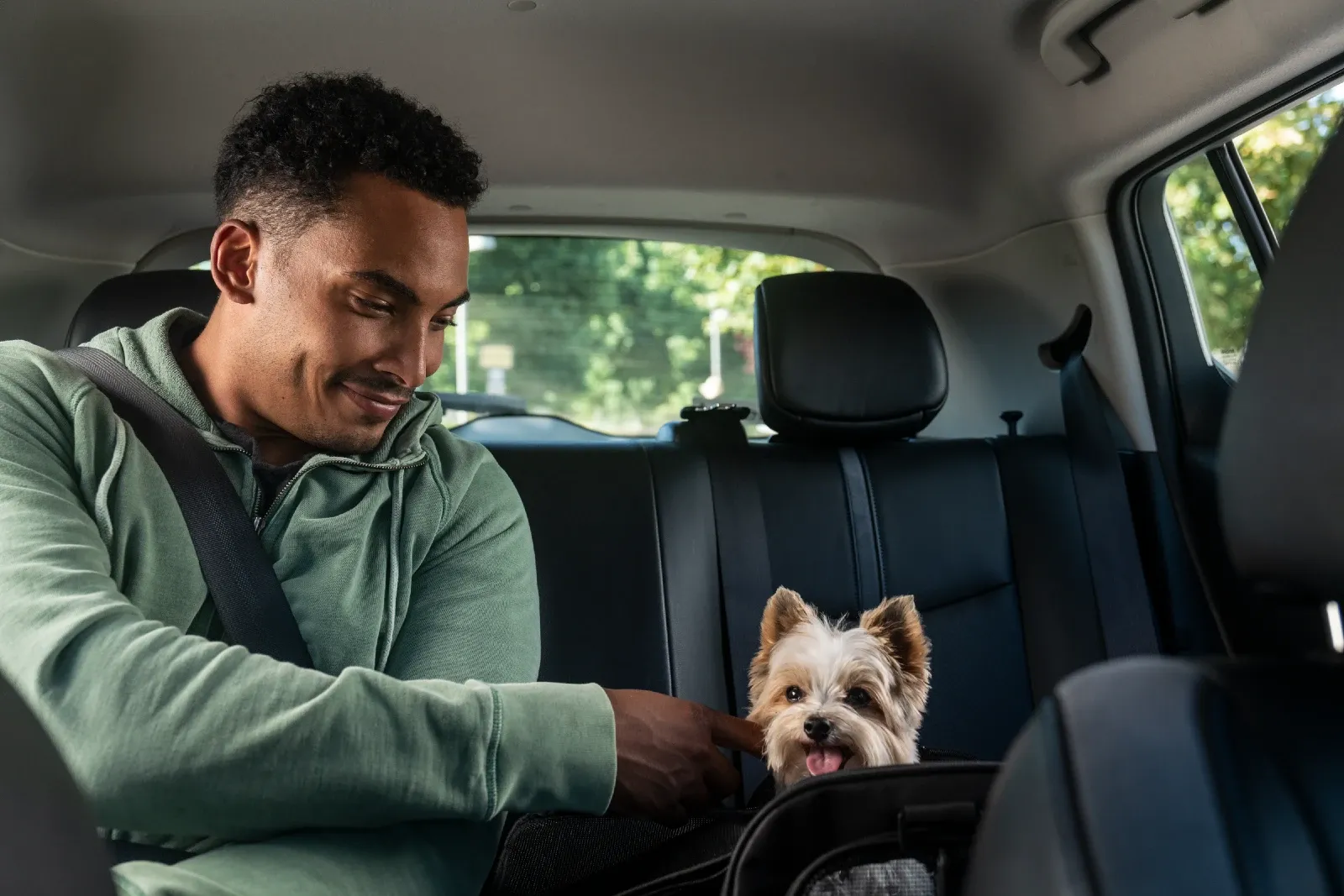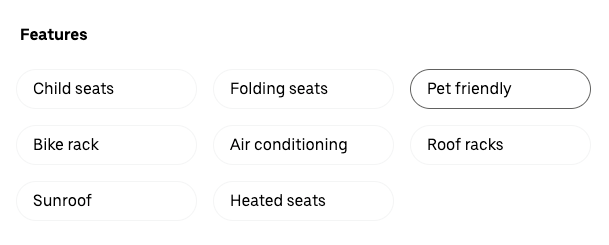
How To Travel Around Australia With Your Dog?
Want to bring your fur-friend along for a trip? No, you’re not barking mad. Travelling with your dog can be a wonderful way to see Australia. Here are our tips for making your journey both dog and owner friendly.
Get your tails wagging with our guide to travelling Australia with your pooch.
Research from Animal Medicines Autralia shows that since the start of the pandemic there has been a substantial increase in pet ownership across Australia, with 69% of households owning a pet in 2021, up from 61% in 2019. That increase included a million additional dogs joining Aussie families.
This means there are a lot of dog-loving people, most of whom also love exploring our wonderful country.
So, many will have either travelled with their dogs or wondered whether their fur-baby might be able to join them on their next adventure. Welcome to the ultimate guide showing you how to travel around Australia with your dog.
Benefits of travelling with dogs
The main benefit of bringing your best friend along for your adventure is that you don’t need to be separated. Whether this is for your peace of mind or your pup’s happiness, being together while you’re on the road brings benefits for all.
Travelling with your dog can lower the cost of kenneling. And, as finding a kennel is getting harder (especially during peak times like school holidays) taking your furry-friend with you might be your only option.
People who travel with their dogs around Australia say that it’s a great way to meet fellow travellers, slow down and travel more mindfully.
Drawbacks of travelling around Australia with a dog
Even with all these benefits, there are some potential downsides to taking your dog on your travels. You need to allow time and space for their needs in addition to your own, so keep reading for tips and checklists.
And, your four-legged friend will limit where you can go, both for staying overnight and for exploring during the day. Read on for tips on finding pet-friendly accommodation and restrictions for places like national parks.
A important note about assistance dogs
Most of the restrictions covered in this article don't apply to assistance dogs. Also called ‘service dogs’ these are working animals that are trained to help people who need help with everyday tasks. Assistance dogs are welcome in most public spaces so are also allowed to be within national parks and on transport that aren't open to pet dogs.
Types of transport
Whether you’re travelling by train, plane or automobile, check out this guide to bringing your dog along for the ride.
Your own car: Taking your own car is the easiest dog car travel option. However, if your car is needed by others at home or if you’ve joined the increasing numbers of people who choose not to own a car (perhaps for environmental or financial reasons), let’s explore other options.
Hire cars: Many traditional hire car companies don't allow pets and others are unclear in their policies. Decisions vary between branches of the same overall company, making planning difficult.
Uber Carshare: Hiring a car through Uber Carshare makes it easy to choose a pet-friendly vehicle. Whether you’re on the website or the app, simply filter your search with the pet-friendly option. Select ‘Filter’ then select ‘Pet friendly’ under the ‘Features’ opinions.
When looking at individual cars, you’ll know they’re pet-friendly when you see the little paw print within the Features section of the vehicle’s description. Of course, you’ll need to leave the car pet hair-free before returning it.

Taxis and Ubers: Different taxi drivers and companies have varying policies about transporting dogs along with their humans. Uber has a Pet option which allows you to book specific cars and drivers who will welcome both you and your dog.
Public transport: Local and interstate trains, trams and busses have varying rules across states and types of transport. Most require you to have your dog within a carrier or box, some restrict you to certain times and others reserve the right to not allow a pet on board if the service is getting full. Research and planning are key to smooth travel and avoiding fines if you plan to use public transport with your pooch.
Planes: For bigger trips, you may need to incorporate a plane flight. Most airlines require you to arrange this via a specific pet carrier service, like Jet Pets.
Let’s get on the road
Once you’re on the road, the fun begins. Your pooch might sleep their way through most of your journey or join in on sing-alongs! Either way, plan your drives so you have time for toilet breaks and exercise.
Your ultimate checklist
From basics (like water and food) to nice-to-haves (like doggy treats and play items), necessities (like poop bags and leashes) and in-case-of-emergencies (like extra bottles of water), our Road Tripping with Dogs 101 Checklist has you covered. Download it and check each box each time you travel.
Car travel time
Consider where and how your pet will be within the car. Even a usually placid dog can become restless during a long trip and there are stories of pets jumping out of windows or becoming an unexpected distraction or hazard to the driver. In the unlikely event of an accident, an unrestrained dog is more susceptible to injury and to hurting others in the car.
All Australian states and territories have road laws preventing pets from travelling on a passenger’s lap and some have fines for carrying an animal unrestrained in a car.
Car harnesses are therefore a good option, as are an enclosed pet carriers that have enough room for your pooch to lie down, sit and stand comfortably. You can even get a pet-specific booster seat, which has the bonus of minimising hair on the upholstery.
What about taking your dog across state borders?
The only state or territory that has requirements for dogs travelling from another part of Australia is Tasmania. If you’re heading to the Apple Isle, your dog needs to have been treated for hydatid tapeworm and be declared tick-free within 24-hours of your arrival.
Overnight stops
Spontaneity and going-with-the-flow can be fun parts of travel but might mean you end up without good overnight options. Planning ahead is more important when you need to consider four-legged as well as two-legged travellers.
Camping
Camping in a pet-friendly place can be ideal accommodation when travelling with dogs. After all, camping is all about the great outdoors and enjoying the simple things in life, which are exactly the things your dog likes best!
Not all campgrounds and holiday parks welcome dogs and some have rules (such as ensuring your dog is on a leash at all times). Be aware that most national park campsites won’t allow pets - see below for more info about dogs in national parks.
Once you’ve found an ideal spot, you can either have room for a furry sleeper in your tent, bring along a separate mini-tent for your dog, or arrange a secure spot for dogs who enjoy sleeping fully under the stars. Read some more dog-friendly camping tips here.
Hotels, motels and more
Local visitor information centres will likely be a gold-mine for information on local dog-friendly accommodation as well as good local daytime doggy-options.
During the day
There are many options for taking your dog with you on your daytime explorations. However, not all places are dog-friendly or welcoming of dogs.
A quick stop at the shops
On longer journeys, or if you are the only human travelling, you need to consider practical trips like going to the shops, as it’s not always safe to leave your dog in the car and not as easy to leave your dog ‘at home’ like you would normally.
Dog-friendly attractions
Travelling with a dog is a great way to encourage you to enjoy the great outdoors and to travel like a local by meeting others on dog-off-lead beaches and dog-exercise parks.
Checking ahead for the dog-friendliness of parks, beaches and attractions in the regions you plan to visit can be all part of the fun of planning a road trip.
Care options
If there are places you want to visit without being accompanied by your four-legged friend, you can check out local kennels or doggy-day-care options (Mad Paws is one pet-sitting specific site worth checking out or you can try general sites like Airtasker).
Another option is to ‘tag team’ with others in your travelling group - where one of you stays with your dog while others explore.
If you are on a longer trip or camping with your dog, some owners sing the praises of arranging ‘pet swaps’ or informal care arrangements with your temporary neighbours. Longer-term campers, including grey nomads, might be content to stick to the campground for half a day while enjoying your dog’s company.
Do your travels take you to Sydney? If so, we’ve got two great blogs for you! One covers the best dog-friendly beaches as the other is an overview of the best walks, pubs and doggy day-care options.
What about national parks?
Dogs are not allowed within most national parks within Australia. This rule is there to protect wildlife, as even the scent of a well-behaved dog on a lead can cause stress to native animals. But it is also there to protect your dog, as national parks are prime places for ticks, snakes and fox baits.
There are some parks where dogs are welcome in specific areas, like these ones in South Australia and these ones in Victoria. You can check each state’s national parks website for details of parks where dogs are welcome.
Keeping your dog safe
ID time
You’re obviously going to look after your pooch carefully but, in the unlikely event that they become separated and lost, these two steps will lead to you being reunited quickly and successfully.
Ensure your furry friend has a securely attached ID tag with your contact details clearly accessible. You’ve likely already got your dog microchipped but, if your travels will take you interstate, ensure it is registered on a national database.
Basic health readiness
A pre-travel vet visit is a great time to ensure your dog is up to date on their vaccinations as well as get up to speed with flea, tick and worming medications. If you’re concerned about dogs that don’t travel well, including travel sickness, use this trip to explore options.
Hot car alert
Just like children, your fur-baby is susceptible to the shocking effects of heat buildup that happens in a car on a warm day. The RSPCA warns that it can take only six minutes for a dog in a hot car to die, even if the car is in the shade.
If that's not enough deterrent, criminal charges, fines and even jail-time can be a result of leaving your dog to suffer. Dogs experiencing heat stress pant, drool and become restless, with weakness, vomiting or seizures occurring if the dog is not carefully cooled down.
Ticks, baits and other dangers
Travel in new places means being aware of new risks. Ticks are common in many parts of Australia and their bites can cause anything from minor irritation to serious disease. Regular inspection and learning how to identify and remove ticks is important if you plan to travel in tick-prone areas.
Baiting of feral animals like foxes uses the poison 1080, which is a serious hazard for dogs. Be aware of warning signs and keep your dog well away from these areas and seek immediate assistance from a vet or the Animal Poisons Centre if you suspect poisoning may have occurred.
We all know that Australia is home to many venomous snakes, which are most active in spring and summer. If your dog is bitten, you can apply a firm bandage along the length of the limb and keep them calm while hurrying to a vet.
Vet contacts
Finding local vets is easy, thanks to the wonders of the internet. But, if you’re heading somewhere more remote, or if your dog has pre-existing health issues, it can be worth doing some prior research about the location and availability of veterinary assistance.
Prepare and practice before you go
If your trip is anything other than short and straightforward, it’s worth doing some practice before you head off. Get your dog used to the car and trial any harness or other bedding options.
Keeping you inspired
Once you’re travelling with your dog, you’ll be far from alone! Link in with others travelling Australia with a dog by saying hello to others you see on your journey and joining social media groups, like the Travel Australia with Dogs Facebook group or using the hashtag #traveldogsaustralia on Instagram.
And, if you’re travelling in a Uber Carshare, don’t forget to share your pics using the hashtag #UberCarshare on your social posts of your travels around Australia with a dog!
Information included in this article is accurate as of (12 Dec 2022). The information published on this blog is of a general nature only and does not consider your personal objectives, financial situation or particular needs. Images used in this article are free to use images under the creative commons license.








